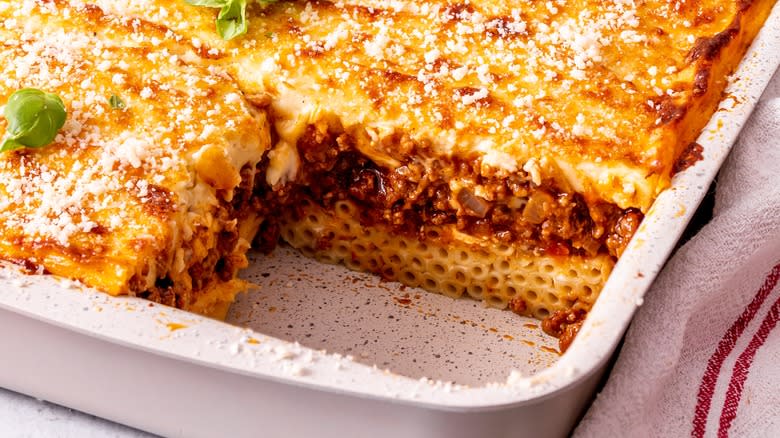The Pasta Type You Need For Traditional Greek Pastitsio

Greek cuisine takes inspiration from the vibrant flavors of the Mediterranean. While many of the Greek dishes you may be familiar with include bright, acidic ingredients like lemon, olives, tomato, and feta cheese, there is a hearty, meaty, and creamy dish you need to try: Pastitsio. Traditional pastitsio is made of three main parts: a pasta layer, a ground meat ragu layer, and a thick upper layer of creamy béchamel sauce. It's baked in a rectangular pan, similar to lasagna (some even call it lasagna's cousin). There are many variations of pastitsio recipes outside of Greece, usually called Greek lasagna.
Pastitsio pasta is preferred in Greece when making this dish. Pastitsio pasta is essentially uncut macaroni -- a long, thin, and hollow noodle. If you can't find pastitsio pasta, many people use bucatini, which is like hollow spaghetti. Let's dive further into why certain kinds of pasta noodles are essential for giving this dish its beautiful and distinctive look.
Read more: French Cooking Tricks You Need In Your Life
Why Do Shapes Matter?

The use of round hollow pasta shapes gives baked, sliced pastitsio a beautiful cross-section of circles on the bottom. The hollow tubular shape of the pastitsio pasta is also ideal for capturing all the fabulous sauce from the ragu and béchamel once the pastitsio is cut.
While a traditional Greek pastitsio will use pastitsio-specific pasta, this is not always as readily available. As mentioned, in this case, it's best to turn to the next best thing: Bucatini pasta. Bucatini is believed to have originated from the Lazio region in Italy, and its long, thin tubular shape is relatively similar to the pastitsio except for having a smaller diameter. If bucatini is also hard to find, other types of tubular pasta like penne or ziti can do the trick.
While the type of pasta is unlikely to affect the flavor of the pasistitio, it will impact the texture and the visual presentation. Tighter tubes, like pastitsio and bucatini, will give the dish more dense pasta in each bite. These smaller tubes will also provide a more traditional presentation of the pastitisio.
The History Of Pastitsio

Pastitsio is believed to have been developed from the Italian dish "pasticcio," a pie filled with sauce, pasta, and meat (which some sources date back as far as the 14th century). Even after the dish made its way to Greece, many variations were created from region to region. But where did the version we know and love today come from?
The pastitsio that is enjoyed today is believed to have developed from Greek chef Nikólaos Tselementés in the early 20th century, who, after training in France, reinvented the classic pastitsio with a béchamel topping instead of dough. And while you do see slight variations of pastitsio out there, including pasta remains a key part of this dish.
If you're up for making pastitsio, get ahold of some tubular-shaped pasta to create the most common traditional variation. If you're feeling adventurous, you may even wish to try making a truly original version, using dough instead of a béchamel -- but we'll leave that up to you.
Read the original article on Daily Meal.

 Yahoo Finance
Yahoo Finance 